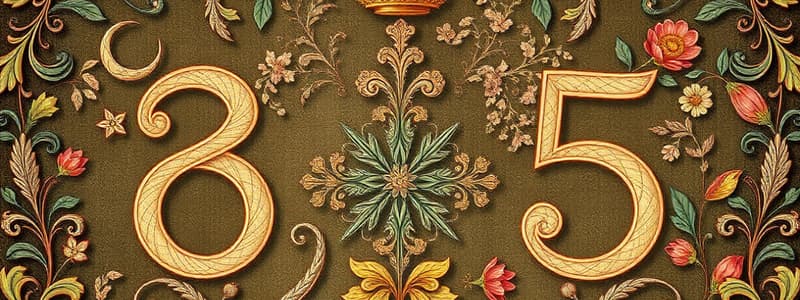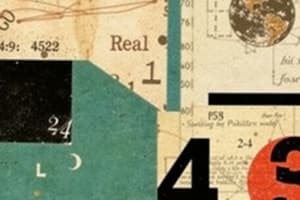Podcast
Questions and Answers
What is the absolute value of -5?
What is the absolute value of -5?
- 0
- 10
- -5
- 5 (correct)
Which of the following is NOT a valid interval notation?
Which of the following is NOT a valid interval notation?
- (2, 5] (correct)
- (-∞, 4]
- [1, ∞)
- [2, 5]
- (3, 7)
If a > b and c < 0, then which of the following is true?
If a > b and c < 0, then which of the following is true?
- ac > bc
- a/c > b/c
- ac < bc (correct)
- a + c > b + c
What is the value of the expression: (-3)^2 + 2 * (-4)?
What is the value of the expression: (-3)^2 + 2 * (-4)?
If the sum of two real numbers is 10 and their difference is 4, what is the larger number?
If the sum of two real numbers is 10 and their difference is 4, what is the larger number?
Which of the following statements is true regarding rational numbers?
Which of the following statements is true regarding rational numbers?
Which property of real numbers allows the rearrangement of terms in an addition operation?
Which property of real numbers allows the rearrangement of terms in an addition operation?
If a = 4 and b = 5, which property of real numbers is illustrated by the equation a + b = b + a?
If a = 4 and b = 5, which property of real numbers is illustrated by the equation a + b = b + a?
Which subset of real numbers includes all the negative integers?
Which subset of real numbers includes all the negative integers?
Which of the following numbers is classified as irrational?
Which of the following numbers is classified as irrational?
What does the absolute value of a real number represent?
What does the absolute value of a real number represent?
Which property ensures that the sum of two real numbers is also a real number?
Which property ensures that the sum of two real numbers is also a real number?
What is the symbol used to denote the set of all real numbers?
What is the symbol used to denote the set of all real numbers?
Flashcards
Absolute value
Absolute value
The distance of a number from zero on the number line.
Open interval
Open interval
An interval (a, b) that does not include its endpoints a and b.
Closed interval
Closed interval
An interval [a, b] that includes both endpoints a and b.
Order properties
Order properties
Signup and view all the flashcards
Order of operations
Order of operations
Signup and view all the flashcards
Real Numbers
Real Numbers
Signup and view all the flashcards
Rational Numbers
Rational Numbers
Signup and view all the flashcards
Irrational Numbers
Irrational Numbers
Signup and view all the flashcards
Closure Property
Closure Property
Signup and view all the flashcards
Commutative Property
Commutative Property
Signup and view all the flashcards
Associative Property
Associative Property
Signup and view all the flashcards
Identity Property
Identity Property
Signup and view all the flashcards
Study Notes
Real Numbers
- Real numbers encompass all numbers that can be represented on a number line, including rational and irrational numbers.
- Rational numbers are numbers that can be expressed as a fraction p/q, where p and q are integers and q is not zero. Examples include integers, fractions, and terminating or repeating decimals.
- Irrational numbers cannot be expressed as a fraction of two integers. Examples include √2, π, and e. They have non-repeating, non-terminating decimal representations.
- Real numbers are ordered and have a well-defined addition and multiplication operations.
- The set of real numbers is denoted by the symbol 'ℝ'.
Properties of Real Numbers
- Closure: If a and b are real numbers, then a + b and a * b are also real numbers.
- Commutative Property: a + b = b + a and a * b = b * a
- Associative Property: (a + b) + c = a + (b + c) and (a * b) * c = a * (b * c)
- Distributive Property: a * (b + c) = a * b + a * c
- Identity Property: There exists a unique real number 0 such that a + 0 = a for all real numbers a. There exists a unique real number 1 such that a * 1 = a for all real numbers a.
- Inverse Property: For every real number a, there exists a unique real number -a such that a + (-a) = 0. For every non-zero real number a, there exists a unique real number 1/a such that a * (1/a) = 1.
Subsets of Real Numbers
- Natural Numbers (N): The set of positive integers. {1, 2, 3,...}
- Whole Numbers (W): The set of natural numbers and zero. {0, 1, 2, 3,...}
- Integers (Z): The set of whole numbers and their negative counterparts. {..., -3, -2, -1, 0, 1, 2, 3,...}
- Rational Numbers (Q): Numbers that can be expressed as a fraction p/q where p and q are integers and q ≠ 0.
- Irrational Numbers (Q'): Numbers that cannot be expressed as a fraction of two integers.
Real Number Line
- The real number line is a graphical representation of real numbers.
- Each point on the line corresponds to a unique real number.
- The real number line extends infinitely in both positive and negative directions.
- The order of real numbers is directly reflected on the number line. A number to the right on the number line is greater than a number to its left.
Absolute Value
- The absolute value of a real number a, denoted as |a|, is the distance of a from zero on the number line.
- |a| is always non-negative.
- |a| = a if a ≥ 0 and |a| = -a if a < 0
Intervals
- Open intervals (a, b) contain all real numbers between a and b, but not including a and b.
- Closed intervals [a, b] contain all real numbers between a and b, including a and b.
- Half-open intervals [a, b) and (a, b] contain some of the endpoints.
Order Properties
- If a > b, then a is to the right of b on the number line.
- If a < b, then a is to the left of b on the number line.
- Transitive Property of Order: If a > b and b > c, then a > c. If a > b, then a + c > b + c. If a > b and c > 0, then ac > bc
Real Number Operations
- Addition, subtraction, multiplication, and division are fundamental operations on real numbers.
- The order of operations (PEMDAS/BODMAS) applies to expressions involving real numbers.
- Rules for adding, subtracting, multiplying, and dividing real numbers follow specific procedures.
Studying That Suits You
Use AI to generate personalized quizzes and flashcards to suit your learning preferences.




